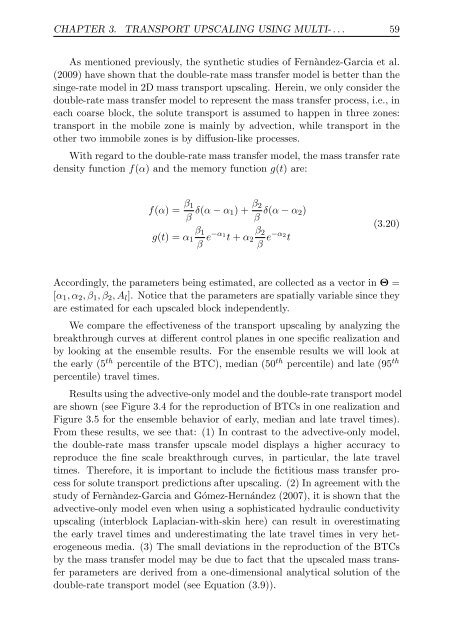Upscaling and Inverse Modeling of Groundwater Flow and Mass ...
Upscaling and Inverse Modeling of Groundwater Flow and Mass ...
Upscaling and Inverse Modeling of Groundwater Flow and Mass ...
Create successful ePaper yourself
Turn your PDF publications into a flip-book with our unique Google optimized e-Paper software.
CHAPTER 3. TRANSPORT UPSCALING USING MULTI- . . . 59<br />
As mentioned previously, the synthetic studies <strong>of</strong> Fernàndez-Garcia et al.<br />
(2009) have shown that the double-rate mass transfer model is better than the<br />
singe-rate model in 2D mass transport upscaling. Herein, we only consider the<br />
double-rate mass transfer model to represent the mass transfer process, i.e., in<br />
each coarse block, the solute transport is assumed to happen in three zones:<br />
transport in the mobile zone is mainly by advection, while transport in the<br />
other two immobile zones is by diffusion-like processes.<br />
With regard to the double-rate mass transfer model, the mass transfer rate<br />
density function f(α) <strong>and</strong> the memory function g(t) are:<br />
f(α) = β1<br />
β δ(α − α1) + β2<br />
δ(α − α2)<br />
β<br />
β1<br />
g(t) = α1<br />
β e−α1 β2<br />
t + α2<br />
β e−α2t (3.20)<br />
Accordingly, the parameters being estimated, are collected as a vector in Θ =<br />
[α1, α2, β1, β2, Al]. Notice that the parameters are spatially variable since they<br />
are estimated for each upscaled block independently.<br />
We compare the effectiveness <strong>of</strong> the transport upscaling by analyzing the<br />
breakthrough curves at different control planes in one specific realization <strong>and</strong><br />
by looking at the ensemble results. For the ensemble results we will look at<br />
the early (5 th percentile <strong>of</strong> the BTC), median (50 th percentile) <strong>and</strong> late (95 th<br />
percentile) travel times.<br />
Results using the advective-only model <strong>and</strong> the double-rate transport model<br />
are shown (see Figure 3.4 for the reproduction <strong>of</strong> BTCs in one realization <strong>and</strong><br />
Figure 3.5 for the ensemble behavior <strong>of</strong> early, median <strong>and</strong> late travel times).<br />
From these results, we see that: (1) In contrast to the advective-only model,<br />
the double-rate mass transfer upscale model displays a higher accuracy to<br />
reproduce the fine scale breakthrough curves, in particular, the late travel<br />
times. Therefore, it is important to include the fictitious mass transfer process<br />
for solute transport predictions after upscaling. (2) In agreement with the<br />
study <strong>of</strong> Fernàndez-Garcia <strong>and</strong> Gómez-Hernández (2007), it is shown that the<br />
advective-only model even when using a sophisticated hydraulic conductivity<br />
upscaling (interblock Laplacian-with-skin here) can result in overestimating<br />
the early travel times <strong>and</strong> underestimating the late travel times in very heterogeneous<br />
media. (3) The small deviations in the reproduction <strong>of</strong> the BTCs<br />
by the mass transfer model may be due to fact that the upscaled mass transfer<br />
parameters are derived from a one-dimensional analytical solution <strong>of</strong> the<br />
double-rate transport model (see Equation (3.9)).


